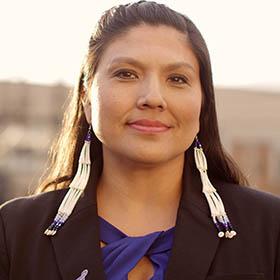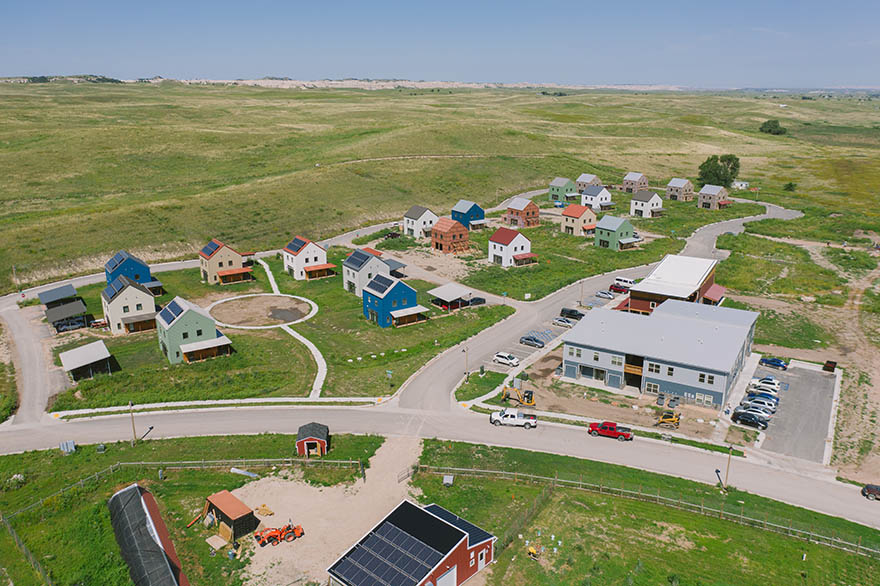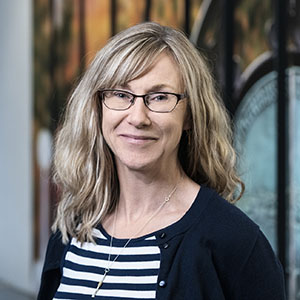
“For [the Lakota people], liberation, sovereignty, self-determination—that starts with the individual,” Means says, “and we hope to start those ripple effects with each of our staff members, so that they can be empowered to be that change in their families.”
Thunder Valley CDC serves approximately 33,000 residents of the Pine Ridge Indian Reservation, located on over 2.2 million acres that you’d find within the borders of South Dakota on a map of the United States. Eight initiatives and programs comprise the nonprofit’s work, including efforts devoted to education, youth leadership, food sovereignty, the Lakota language, housing and home ownership, workforce development, and social enterprise. Each area is just one part of its “holistic approach to liberation.”
Liberation is central for Thunder Valley CDC because of the Lakota’s history. In the early-1800s, the US government began to enact laws and policies that would push Native Americans westward, eventually confining them to reservations. Both systematic and strategic, these efforts stripped the Lakota and other Native American tribes of their lands, their economy, their health, and their cultures. Assimilation efforts, including the conversion to Christianity, further delegitimized their traditions and spiritual beliefs. “Our way of life was severely impacted by colonization,” Means says. “So [through our work], we are really taking aim at all of the damaging and negative impacts that colonization has had on our community.”
Today, Thunder Valley CDC’s place-based approach to sustainability on the Pine Ridge reservation intends to restore the Lakota way of life by deeply rooting its work to end poverty in its spirituality and culture. Founded in 2007, the grassroots Indigenous-led and operated organization was born of one of the Lakota’s seven sacred ceremonies and has been guided by the idea that change happens through hope, not fear.
In July 2018, Means joined Thunder Valley CDC as executive director after having served in roles as attorney general for the Oglala Sioux Tribe and then as deputy states attorney—the chief law enforcement officer of the territory. Working in systems that “were designed to be oppressive,” Means says, inspired her to advocate in a different way.
“I wanted to be a part of a movement that was by the people, and that was for the people, and that was based in who we are as Indigenous people,” she says. “You hear it all the time: people from our community say we have the solutions for our own communities. And so it’s just a matter of trusting ourselves to implement those solutions.”
Changing Minds and Building Leaders
Thunder Valley CDC’s programs and initiatives create job opportunities, build housing, revitalize the Lakota language, foster youth leadership, and much more, to help build a sustainable community that honors their heritage and respects their environment. Yet, notes Means, overcoming years of oppression goes beyond programs and initiatives. It will take changing the mindsets of her community.
“We can provide the opportunities, the places to live, the pathways, but if we’re not fundamentally changing the way people think about the world and their lives, and then act upon those thoughts, then it’s for nothing.”
Doing the hard work internally
-400.jpg)
of Thunder Valley's Social Enterprise Initiative (Photo: Kenyon Andres)
The first step to inspiring this type of change meant building the leadership capacity of Thunder Valley CDC’s team. Having worked with Bridgespan through the Investing in Future Leaders Program, Means learned that embedding development within an organization’s day-to-day work inspired her staff to take ownership of their development. “It doesn't feel like it’s something else to add to their to-do lists or that there'll be a consequence if they don’t fulfill it,” she says. “It doesn’t feel like an obligation—it feels like an opportunity.”
She also recognized that traditional leadership competencies and her staff’s progression through them would need to look different. “Getting to the heart of liberation, to decolonization, and how do I get myself to think as a Lakota once again,” says Means, “didn’t align with scales that suggested one was a beginner or advanced at a particular leadership competency [such as strategic thinking or decision making]." Thunder Valley’s leadership team developed more culturally relevant competencies, such as one’s understanding of their Lakota identity, where self-reflection served as a better approach to development.
Helping build leaders externally
Thunder Valley CDC is seeding future advocates and leaders not only within the nonprofit but also throughout the Pine Ridge community. “We have a youth board member representative on our board of directors to always bring that perspective and hopefully empower young people to be more active in the organization going forward,” Means says. And the nonprofit’s youth leadership initiative provides young people the opportunity to develop leadership skills as well as the knowledge of the history and culture of the Lakota people. “We’re just creating all of these avenues and pathways for young people to engage in the work and to plant those seeds for future leaders to come back and take over guiding the organization.”
Looking out five years, Means is hopeful that the nonprofit’s services and its work in developing a community of leaders will lead to progress against its goal of liberation. And she sees Thunder Valley CDC’s role as a steward of this collective journey. “As an organization,” Means says, “I hope we've made progress in writing our community’s healing story. Ultimately, we’re accountable to our community—that’s one thing that has always been inherent to our people—the sense of responsibility we have to one another.”




